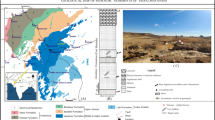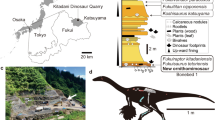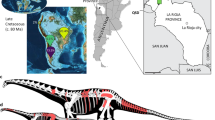Abstract
The origin of the last sauropod dinosaur communities in Europe and their evolution during the final 15 million years of the Cretaceous have become a complex phylogenetic and palaeobiogeographic puzzle characterized by the controversy on the alleged coexistence of immigrant, Gondwana-related taxa alongside relictual and insular clades. In this context, we describe a new titanosaurian sauropod dinosaur, Abditosaurus kuehnei gen. et sp. nov., from the Late Cretaceous (Maastrichtian) Tremp Group of Catalonia (Spain). Phylogenetic analyses recover Abditosaurus separately from other European titanosaurs, within a clade of otherwise South American and African saltasaurines. The affinity of the new taxon with southern landmasses is reinforced by spatiotemporal co-occurrence with Gondwanan titanosaurian oospecies in southern Europe. The large size and the lack of osteohistological features potentially related to insular dwarfism or size reduction support the idea that Abditosaurus belongs to an immigrant lineage, unequivocally distinct from some of the island dwarfs of the European archipelago. The arrival of the Abditosaurus lineage to the Ibero–Armorican Island is hypothesized to have occurred during the earliest Maastrichtian (70.6 Ma), probably as a result of a global and regional sea-level drop that reactivated ancient dispersal routes between Africa and Europe. The arrival of large-bodied titanosaurs to the European archipelago produced dramatic changes in its insular ecosystems and important evolutionary changes in its dinosaur faunas, especially with respect to the ‘island rule’ effect.
This is a preview of subscription content, access via your institution
Access options
Access Nature and 54 other Nature Portfolio journals
Get Nature+, our best-value online-access subscription
$29.99 / 30 days
cancel any time
Subscribe to this journal
Receive 12 digital issues and online access to articles
$119.00 per year
only $9.92 per issue
Buy this article
- Purchase on Springer Link
- Instant access to full article PDF
Prices may be subject to local taxes which are calculated during checkout




Similar content being viewed by others
Data availability
This published work and the nomenclatural acts it contains have been registered in ZooBank, the proposed online registration system for the International Code of Zoological Nomenclature (ICZN). The ZooBank LSIDs can be resolved and the associated information viewed through any standard web browser by appending the LSID to the prefix ‘http://zoobank.org/’. All other data supporting the findings of this study are available within the paper and its Supplementary Information.
References
Le Loeuff, J., Buffetaut, E. & Martin, M. The last stages of dinosaur faunal history in Europe: a succession of Maastrichtian dinosaur assemblages from the Corbières (southern France). Geol. Mag. 131, 625–630 (1994).
Vila, B., Sellés, A. G. & Brusatte, S. L. Diversity and faunal changes in the latest Cretaceous dinosaur communities of southwestern Europe. Cretac. Res. 57, 552–564 (2016).
Fondevilla, V. et al. Chronostratigraphic synthesis of the latest Cretaceous dinosaur turnover in south-western Europe. Earth Sci. Rev. 191, 168–189 (2019).
Sanz, J. L., Powell, J. E., Le Loeuff, J., Martínez, R. & Pereda-Suberbiola, X. Sauropod remains from the Upper Cretaceous of Laño (northcentral Spain). Titanosaur phylogenetic relationships. Est. Mus. Cienc. Nat. Alava 14, 235–255 (1999).
Garcia, G., Amico, S., Fournier, F., Thouand, E. & Valentin, X. A new titanosaur genus (Dinosauria, Sauropoda) from the Late Cretaceous of southern France and its paleobiogeographic implications. Bull. Soc. Géol. Fr. 181, 269–277 (2010).
Díez Díaz, V. et al. A new titanosaur (Dinosauria: Sauropoda) from the Upper Cretaceous of Velaux La-Bastide Neuve (southern France). Hist. Biol. https://doi.org/10.1080/08912963.2020.1841184 (2020).
Le Loeuff, J. Ampelosaurus atacis (nov. gen., nov. sp.), a new titanosaurid (Dinosauria, Sauropoda) from the Late Cretaceous of the Upper Aude Valley (France). C. R. Acad. Sci. II 321, 693–700 (1995).
Díez Díaz, V. et al. A new titanosaur (Dinosauria, Sauropoda) from the Upper Cretaceous of Lo Hueco (Cuenca, Spain). Cretac. Res. 68, 49–60 (2016).
Company, J. Bone histology of the titanosaur Lirainosaurus astibiae (Dinosauria: Sauropoda) from the latest Cretaceous of Spain. Naturwissenschaften 98, 67–78 (2011).
Klein, N. et al. Modified laminar bone in Ampelosaurus atacis and other titanosaurs (Sauropoda): implications for life history and physiology. PLoS ONE 7, e36907 (2012).
Díez Díaz, V. et al. The titanosaurian dinosaur Atsinganosaurus velauciensis (Sauropoda) from the Upper Cretaceous of southern France: new material, phylogenetic affinities, and palaeobiogeographical implications. Cretac. Res. 91, 429–456 (2018).
Benítez-López, A. et al. The island rule explains consistent patterns of body size evolution in terrestrial vertebrates. Nat. Ecol. Evol. 5, 768–786 (2021).
Benton, M. J. et al. Dinosaurs and the island rule: the dwarfed dinosaurs from Haţeg Island. Palaeogeogr. Palaeoclimatol. Palaeoecol. 293, 438–454 (2010).
Canudo, J. I. Descripción de un fragmento proximal de fémur de Titanosauridae (Dinosauria, Sauropoda) del Maastrichtiense superior de Serraduy (Huesca). In Proc. XVII Jornadas de la Sociedad Española de Paleontología (eds Meléndez, G. et al.) 255–262 (Sociedad Española de Paleontología y Área y Museo de Paleontología de la Universidad de Zaragoza, 2001).
Vila, B. et al. The diversity of sauropods and their first taxonomic succession from the latest Cretaceous of south-western Europe: clues to demise and extinction. Palaeogeogr. Palaeoclimatol. Palaeoecol. 350–352, 19–38 (2012).
Sallam, H. M. et al. New Egyptian sauropod reveals Late Cretaceous dinosaur dispersal between Europe and Africa. Nat. Ecol. Evol. 2, 445–451 (2018).
Buffetaut, E. Archosaurian reptiles with Gondwanan affinities in the Upper Cretaceous of Europe. Terra Nova 1, 69–74 (1989).
Le Loeuff, J. The Campano-Maastrichtian vertebrate faunas from southern Europe and their relationships with other faunas in the world; palaeobiogeographical implications. Cretac. Res. 12, 93–114 (1991).
Pereda-Suberbiola, X. Biogeographical affinities of Late Cretaceous continental tetrapods of Europe: a review. Bull. Soc. Geol. Fr. 180, 57–71 (2009).
Csiki-Sava, Z., Buffetaut, E., Ősi, A., Pereda-Suberbiola, X. & Brusatte, S. L. Island life in the Cretaceous – faunal composition, biogeography, evolution, and extinction of land-living vertebrates on the Late Cretaceous European archipelago. ZooKeys 469, 1–161 (2015).
Ezcurra, M. D. & Agnolín, F. L. A new global palaeobiogeographical model for the late Mesozoic and early Tertiary. Syst. Biol. 61, 553–566 (2012).
Sellés, A. G. & Vila, B. Re-evaluation of the age of some dinosaur localities from the southern Pyrenees by means of megaloolithid oospecies. J. Iber. Geol. 41, 125–139 (2015).
Bonaparte, J. F. & Coria, R. A. Un nuevo y gigantesco saurópodo titanosaurio de la Formación Río Limay (Albiano–Cenomaniano) de la Provincia del Neuquén, Argentina. Ameghiniana 30, 217–282 (1993).
Curry Rogers, K. The postcranial osteology of Rapetosaurus krausei (Sauropoda: Titanosauria) from the Late Cretaceous of Madagascar. J. Vertebr. Paleontol. 29, 1046–1086 (2009).
Zurriaguz, V. & Powell, J. New contributions to the presacral osteology of Saltasaurus loricatus (Sauropoda, Titanosauria) from the Upper Cretaceous of northern Argentina. Cretac. Res. 54, 283–300 (2015).
Coria, R. A., Filippi, L. S., Chiappe, L. M., García, R. & Arcucci, A. B. Overosaurus paradasorum gen. et sp. nov., a new sauropod dinosaur (Titanosauria: Lithostrotia) from the Late Cretaceous of Neuquén, Patagonia, Argentina. Zootaxa 3683, 357–376 (2013).
Calvo, J. O., González Riga, B. J. & Porfiri, J. D. A new titanosaur sauropod from the Late Cretaceous of Neuquén, Patagonia, Argentina. Arq. Mus. Nac. 65, 485–504 (2007).
Jain, S. L. & Bandyopadhyay, S. New titanosaurid (Dinosauria: Sauropoda) from the Late Cretaceous of central India. J. Vertebr. Paleontol. 17, 114–136 (1997).
Gorscak, E. & O’Connor, P. M. A new African titanosaurian sauropod dinosaur from the middle Cretaceous Galula Formation (Mtuka Member), Rukwa Rift Basin, southwestern Tanzania. PLoS ONE 14, e0211412 (2019).
Kellner, A. W. A. & de Azevedo, S. A. K. A new sauropod dinosaur (Titanosauria) from the Late Cretaceous of Brazil. Nat. Sci. Mus. Monogr. 15, 111–142 (1999).
Novas, F. E. et al. Paleontological discoveries in the Chorrillo Formation (upper Campanian-lower Maastrichtian, Upper Cretaceous), Santa Cruz Province, Patagonia, Argentina. Rev. Mus. Argent. Cienc. Nat. 21, 217–293 (2019).
Wilson, J. A., D’Emic, M. D., Curry Rogers, K. A., Mohabey, D. M. & Sen, S. Reassessment of the sauropod dinosaur Jainosaurus (=“Antarctosaurus”) septentrionalis from the Upper Cretaceous of India. Contrib. Mus. Paleontol. Univ. Mich. 32, 17–40 (2009).
Powell, J. E. Revision of South American titanosaurid dinosaurs: palaeobiological, palaeobiogeographical and phylogenetic aspects. Rec. Queen Vic. Mus. 111, 1–173 (2003).
Smith, J. B. et al. A giant sauropod dinosaur from an Upper Cretaceous mangrove deposit in Egypt. Science 292, 1704–1706 (2001).
Otero, A. & Vizcaíno, S. F. Hindlimb musculature and function of Neuquensaurus australis (Sauropoda: Titanosauria). Ameghiniana 45, 333–348 (2008).
von Huene, F. Los saurisquios y ornitisquios del Cretáceo Argentino. Mus. La Plata 3, 1–196 (1929).
Mannion, P. D. & Otero, A. A reappraisal of the Late Cretaceous Argentinean sauropod dinosaur Argyrosaurus superbus, with a description of a new titanosaur genus. J. Vertebr. Paleontol. 32, 614–638 (2012).
Mocho, P., Pérez-García, A., Martín Jiménez, M. & Ortega, F. New remains from the Spanish Cenomanian shed light on the Gondwanan origin of European Early Cretaceous titanosaurs. Cretac. Res. 95, 164–190 (2019).
Díez Díaz, V., Pereda Suberbiola, X. & Sanz, J. L. Appendicular skeleton and dermal armour of the Late Cretaceous titanosaur Lirainosaurus astibiae (Dinosauria: Sauropoda) from Spain. Palaeontol. Electronica 16, 19A (2013).
Le Loeuff, J. in Thunder-Lizards: The Sauropodomorph Dinosaurs (eds Tidwell, V. & Carpenter, K.) 115–137 (Indiana Univ. Press, 2005).
Borsuk-Bialynicka, M. A new camarasaurid sauropod Opisthocoelicaudia skarzynskii gen. n., sp. n. from the Upper Cretaceous of Mongolia. Acta Palaeontol. Pol. 37, 5–63 (1977).
Filippi, L. S., García, R. A. & Garrido, A. A new sauropod titanosaur from the Plottier Formation (Upper Cretaceous) of Patagonia (Argentina). Geol. Acta 9, 1–12 (2011).
Salgado, L., Coria, R. A. & Calvo, J. O. Evolution of titanosaurid sauropods. I: phylogenetic analysis based on the postcranial evidence. Ameghiniana 34, 3–32 (1997).
D’Emic, M. D. The early evolution of titanosauriform sauropod dinosaurs. Zool. J. Linn. Soc. 166, 624–671 (2012).
Tschopp, E. & Mateus, O. Clavicles, interclavicles, gastralia, and sternal ribs in sauropod dinosaurs: new reports from Diplodocidae and their morphological, functional and evolutionary implications. J. Anat. 222, 321–340 (2013).
Wilson, J. A. Sauropod dinosaur phylogeny: critique and cladistic analysis. Zool. J. Linn. Soc. 136, 217–276 (2002).
Powell, J. E. in Los Dinosaurios y Su Entorno Biótico (eds Sanz, J. L. & Buscalioni, A. D.) 165–230 (Instituto ‘Juan de Valdés’, 1992).
Otero, A. The appendicular skeleton of Neuquensaurus, a Late Cretaceous saltasaurine sauropod from Patagonia, Argentina. Acta Palaeontol. Pol. 55, 399–426 (2010).
Gilmore, C. W. Reptilian Fauna of the North Horn Formation of Central Utah Professional Paper 210-C (USGS Numbered Series, 1946).
Ullmann, P. V. & Lacovara, K. J. Appendicular osteology of Dreadnoughtus schrani, a giant titanosaurian (Sauropoda, Titanosauria) from the Upper Cretaceous of Patagonia, Argentina. J. Vertebr. Paleontol. 36, e1225303 (2016).
Poropat, S. F. Carl Wiman’s sauropods: the Uppsala Museum of Evolution’s collection. GFF 135, 104–119 (2013).
Cerda, I. A., Salgado, L. & Powell, J. E. Extreme postcranial pneumaticity in sauropod dinosaurs from South America. Paläontol. Z. 86, 441–449 (2012).
Wilson, J. A. & Carrano, M. T. Titanosaurs and the origin of “wide-gauge” trackways: a biomechanical and systematic perspective on sauropod locomotion. Paleobiol. 25, 252–267 (1999).
Upchurch, P., Barrett, P. & Dodson, P. in The Dinosauria (eds Weishampel, D. B. et al.) 259–324 (Univ. California Press, 2004).
Lehman, T. M. & Coulson, A. B. A juvenile specimen of the sauropod dinosaur Alamosaurus sanjuanensis from the Upper Cretaceous of Big Bend National Park, Texas. J. Paleontol. 76, 156–172 (2002).
Gallina, P. A. & Otero, A. Reassessment of Laplatasaurus araukanicus (Sauropoda: Titanosauria) from the Upper Cretaceous of Patagonia, Argentina. Ameghiniana 52, 487–501 (2015).
Wilson, J. A. & Upchurch, P. Redescription and reassessment of the phylogenetic affinities of Euhelopus zdanskyi (Dinosauria: Sauropoda) from the Early Cretaceous of China. J. Syst. Palaeontol. 7, 199–239 (2009).
Sereno, P. C. A rationale for phylogenetic definitions, with application to the higher-level taxonomy of Dinosauria. Neues Jahrb. Geol. Paläontol. Abh. 210, 41–83 (1998).
Chiappe, L. M. et al. Sauropod dinosaur embryos from the Late Cretaceous of Patagonia. Nature 396, 258–261 (1998).
Haq, B. U. Cretaceous eustasy revisited. Glob. Planet. Change 113, 44–58 (2014).
Gheerbrant, E. & Rage, J.-C. Paleobiogeography of Africa: how distinct from Gondwana and Laurasia? Palaeogeogr. Palaeoclimatol. Palaeoecol. 241, 224–246 (2006).
Canudo, J. I. et al. What Iberian dinosaurs reveal about the bridge said to exist between Gondwana and Laurasia in the Early Cretaceous. Bull. Soc. Géol. Fr. 180, 5–11 (2009).
Dal Sasso, C., Pierangelini, G., Famiani, F., Cau, A. & Nicosia, U. First sauropod bones from Italy offer new insights on the radiation of Titanosauria between Africa and Europe. Cretac. Res. 64, 88–109 (2016).
Stein, K. et al. Small body size and extreme cortical bone remodeling indicate phyletic dwarfism in Magyarosaurus dacus (Sauropoda: Titanosauria). Proc. Natl Acad. Sci. USA 107, 9258–9263 (2010).
Botfalvai, G. et al. ‘X’ marks the spot! Sedimentological, geochemical and palaeontological investigations of Upper Cretaceous (Maastrichtian) vertebrate fossil localities from the Vălioara valley (Densuş-Ciula Formation, Hațeg Basin, Romania). Cretac. Res. 123, 104781 (2021).
Csiki-Sava, Z. et al. The east side story–the Transylvanian latest Cretaceous continental vertebrate record and its implications for understanding Cretaceous–Paleogene boundary events. Cretac. Res. 57, 662–698 (2016).
Campione, N. E. & Evans, D. C. A universal scaling relationship between body mass and proximal limb bone dimensions in quadrupedal terrestrial tetrapods. BMC Biol. 10, 60 (2012).
González Riga, B. J., Lamanna, M. C., Ortiz David, L. D., Calvo, J. O. & Coria, J. P. A gigantic new dinosaur from Argentina and the evolution of the sauropod hind foot. Sci. Rep. 6, 19165 (2016).
Seebacher, F. New method to calculate allometric length–mass relationships of dinosaurs. J. Vertebr. Paleontol. 21, 51–60 (2001).
Mallison, H. & Wings, O. Photogrammetry in paleontology— a practical guide. J. Paleontol. Tech. 12, 1–31 (2014).
Matthews, N., Noble, T. & Breithaupt, B. H. in Dinosaur Tracks—The Next Steps (eds Falkingham, P. L. et al.) 28–55 (Indiana Univ. Press, 2016).
Falkingham, P. L. et al. A standard protocol for documenting modern and fossil ichnological data. Palaeontology 61, 469–480 (2018).
Huelsenbeck, J. P. & Ronquist, F. MRBAYES: Bayesian inference of phylogeny. Bioinformatics 17, 754–755 (2001).
Stadler, T., Kühnert, D., Bonhoeffer, S. & Drummond, A. J. Birth–death skyline plot reveals temporal changes of epidemic spread in HIV and hepatitis C virus (HCV). Proc. Natl Acad. Sci. USA 110, 228–233 (2013).
Matzke, N. J. Probabilistic historical biogeography: new models for founder-event speciation, imperfect detection, and fossils allow improved accuracy and model-testing. Front. Biogeogr. 5, 242–248 (2013).
Ogg, J. G. & Hinnov, L. A. in The Geological Time Scale (eds Gradstein, F. M. et al.) 793–853 (Elsevier, 2012).
Vianey-Liaud, M., Khosla, A. & Garcia, G. Relationships between European and Indian dinosaur eggshells of the oofamily Megaloolithidae. J. Vertebr. Paleontol. 23, 575–585 (2003).
Acknowledgements
We thank J. Montané, E. Aguirre, A. Lacasa and J. V. Santafé for providing key information on early excavations; U. Klebe and A. Klebe for transcripts and translation of WGK’s field notes, and for providing permission to reproduce WGK and field-notes images in Fig. 1 and Supplementary Fig. 2; R. Gaete, J. González, E. Nieto, A. Vallès and I. Fernández for logistics and fossil preparation; all colleagues who participated in the field campaigns; E. Gorscak for kindly providing XML files for BEAST 2.1.3; B. F. Rotatori for assisting with Bayesian phylogenetic methods; M. Belvedere for assisting with photogrammetry techniques; B. González Riga for providing permission to reproduce the skeletal reconstruction in Fig. 1; R. Contreras for providing the image for Supplementary Fig. 3; R. Glasgow for reviewing the English; M. C. Lamanna and V. Díez Díaz for helpful reviews; and J. A. Wilson for constructive feedback on an early version of the manuscript. MNCN provided permissions for the study, sampling and casting of MNCN specimens, and Archivo MNCN-CSIC provided permission to reproduce images for Supplementary Figs. 1 and 2. This research is part of the project I+D+i/PID2020-119811GB-I00 funded by MCIN/ AEI/10.13039/501100011033/ (B.V.). Additional funding was provided by the CERCA Programme and the project CLT009/18/00067 funded by the Generalitat de Catalunya (B.V., A.S. and A.G.), the Committee for Research and Exploration of the National Geographic Society (grant 9148-12 to B.V.), MEIC, MCI and MEC (CGL2017-85038-P, CGL2016-77230-P and CGL2011-30069-C02-01 to A.G., B.V., A.S. and J.I.C.) and Fundação para a Ciência e a Tecnología (PTDC/CTA-PAL/31656/2017, UIDB/04035/2020 and PTDC/CTA-PAL/2217/2021 to M.M.-A.). Fossil preparation was supported by the Servei de Museus–Departament de Cultura of the Generalitat de Catalunya (grants 2015/104328, CLT005/16/00008, CLT005/19/00045) and the Institut d’Estudis Ilerdencs (grant 201602412).
Author information
Authors and Affiliations
Contributions
B.V. devised and directed the project and supervised the fieldwork; B.V., A.S., A.G., N.L.R. and J.I.C. collected the fossils and taphonomic data in the field; B.V., A.S. and A.G. supervised fossil preparation; B.V. described and measured the fossils, and collected historical information; M.M.-A. and B.V. performed phylogenetic and biogeographic analyses; A.G.-D., A.S. and B.V. conducted histological analyses; N.L.R. performed the photogrammetry and 3D modelling; B.V. wrote the paper with substantial inputs from A.S., M.M.-A., A.G.-D. and N.L.R. B.V., A.S. and M.M.-A. designed the figures. B.V., A.S., M.M.-A., N.L.R., A.G.-D., A.G. and J.I.C. reviewed and edited the original draft.
Corresponding author
Ethics declarations
Competing interests
The authors declare no competing interests.
Peer review
Peer review information
Nature Ecology & Evolution thanks Veronica Díez Díaz and Matthew Lamanna for their contribution to the peer review of this work.
Additional information
Publisher’s note Springer Nature remains neutral with regard to jurisdictional claims in published maps and institutional affiliations.
Supplementary information
Supplementary Information
Supplementary Materials and Methods, Results, Tables 1–7 and References.
Supplementary Data
Script for TNT v.1.5 to replicate the parsimony analysis.
Supplementary Data
TNT file including the character scores for the parsimony analyses.
Supplementary Data
Nexus file for MrBayes 3.2.7a to reproduce the non-clock analyses.
Supplementary Data
Script for Beast 2.4.7.
Rights and permissions
About this article
Cite this article
Vila, B., Sellés, A., Moreno-Azanza, M. et al. A titanosaurian sauropod with Gondwanan affinities in the latest Cretaceous of Europe. Nat Ecol Evol 6, 288–296 (2022). https://doi.org/10.1038/s41559-021-01651-5
Received:
Accepted:
Published:
Issue Date:
DOI: https://doi.org/10.1038/s41559-021-01651-5
This article is cited by
-
Titanosaur boom
Nature Ecology & Evolution (2022)



